GOVERNMENT
ACTION THROUGH INTEREST GROUPS
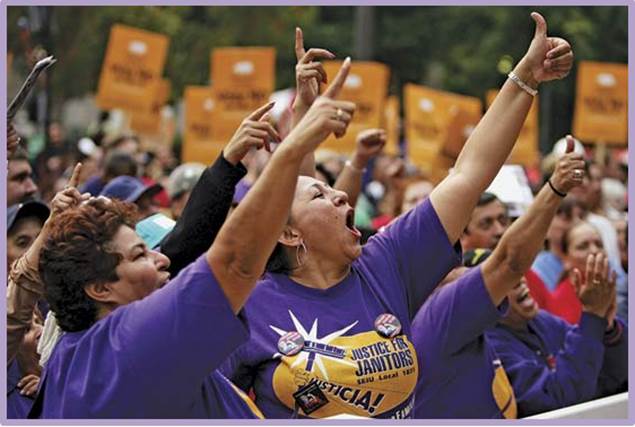
Justice for Janitors Rally
Overview
Along with political parties, interest groups offer
opportunities for citizens to form and to challenge public policies. They use a variety of tactics to connect with
officials and to draw attention to their causes. As the number of these organizations increases,
their effect on American politics becomes more controversial. Are they a help or a hindrance to good
government? When you have completed this
unit, you will have formed your own answer to this question.
What is an Interest Group?
The First Amendment gives Americans the right to
speak freely about causes and issues that concern them. However, getting decision-makers to listen
and creating public awareness can be difficult.
Interest groups are organizations that work to connect with government officials
and strive to make their views known to the general population. Their long-term goal is to shape public
policy. Over 100,000 interest groups
exist within the United States, and they cover a wide variety of topics. To accomplish their tasks, they require
skilled leaders, adequate funding and dedicated members. The more successful the interest group is,
the more influential it becomes.

Activities of
Greenpeace International
Political Parties and Special Interest
Groups
At first glance, interest groups do not seem too
different from political parties. Both
organizations consist of people with definite opinions in common. They also aim to influence public policy,
elections and government officials. Yet,
there are crucial differences between them.
While political parties attempt to bring various groups together through
compromises and coalitions, interest groups usually form around certain problems
or issues, such as the preservation of the environment, tax reform and
employment practices. As a result, the
focus of an interest group is much narrower than that of a political
party. The intent of an interest group
is to affect a specific area of public policy, and this goal does not
change. A political party, on the other
hand, can make changes in its platform and still maintain its purpose.
 Go to Questions 1 through 3.
Go to Questions 1 through 3.
Types of Interest Groups
Even though they address a wide range of issues,
interest groups have one thing in common—they exist to advance the concerns of
their members. Based on their focus,
they can be divided into three broad categories, which sometimes overlap. These include economic interest groups,
social action interest groups and single-issue interest groups.
![]() Special Interest Groups (04:38)
Special Interest Groups (04:38)
Economic Interest Groups
Economic interest groups dedicate themselves to
influencing how the government spends its money and from whom it collects
taxes. Business and trade associations,
like the National Association of Manufacturers, try to create a favorable
climate for the growth and prosperity of businesses. Professionals, including teachers, actors and
lawyers, rely on interest groups to protect and advance their fields. Certain groups also speak on behalf of the
American farmer. Some of the best-known
and most active groups are sponsored by labor unions. Police, firefighters and other public
employees are represented by the American Federation of Government Employees and
other similar organizations. The chart
below lists several additional examples.

Social Action Groups
Some interest groups try to bring about changes in
society based on the principles and values of their members. A number of organizations have continued the
struggle to extend the promises made by the Constitution to all Americans. The National Association for the Advancement
of Colored People (NAACP) and the American Association of Retired Persons
(AARP) have large membership bases and work to improve conditions for
minorities. The American Legion and the
Veterans of Foreign Wars have successfully pressured Congress to increase
funding for the Department of Veterans Affairs.
This action has provided health care, loans and educational
opportunities for those who have performed military service. Although the United States has a long
tradition of separating church and state, religious groups have become
increasingly involved in politics and public policy. For example, the National Conference of
Catholic Bishops uses its status as an interest group to protest government
policies that are inconsistent with Catholic doctrine. Interest groups also promote participation in
government through organizations like the League of Women Voters. The Sierra Club and other environmental
groups encourage government programs to preserve the wilderness and to protect
wildlife. The chart below shows some
additional examples interest groups devoted to social action.
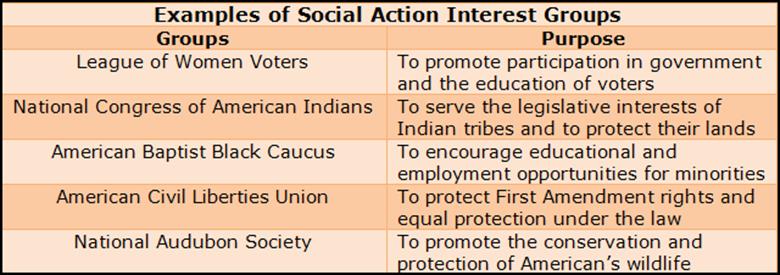
Single-Issue Interest Groups
People who join single-issue interest groups have
strong feelings on a particular subject and support the cause with forceful
determination. In recent years, these
types of organizations have increased.
This has happened, in part, because, when one group supports a
controversial issue, another group forms to counteract it. For example, the National Rifle Association,
which upholds the right of people to bear arms for self-defense and sport, is
opposed by Handgun Inc., which promotes more government regulations on
firearms. Other single-issue interest
groups are listed below.
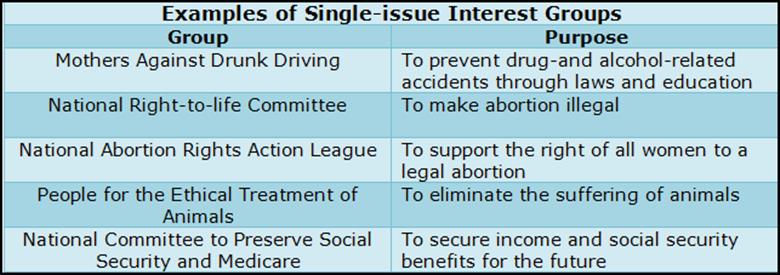
 Go to Questions 4 through 7.
Go to Questions 4 through 7.
How Interest Groups Accomplish Their Goals
To accomplish their mission, interest groups must
attract the attention of the American public and government officials. They accomplish this by incorporating a
number of tactics. These include
lobbying, electioneering, grassroots campaigns, public demonstrations and legal
action.
Lobbying
In the 1830s, citizens gathered in the lobby of the
United States Capitol in an attempt to influence congressional votes on
proposed laws. The practice also carried
over into state capitols as legislators prepared to discuss certain bills. The custom became known as lobbying, and
today, professional lobbyists represent interest groups, foreign businesses,
foreign governments and U.S. corporations.
They contact government officials and try to shape public policy by
explaining the positions of their clients.
This involves supplying well-researched information, testifying at
congressional hearings and doing favors.
All of this is powered by large amounts of money. The list below shows the biggest spenders on this
service in recent years.
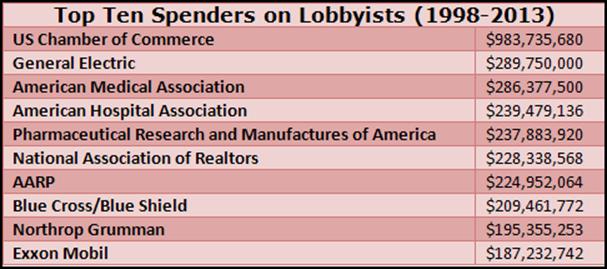
Unfortunately, some lobbyists also resorted to
bribery, and this led to several regulations on lobbying. In an
attempt to control corruption, any person or group attempting to sway federal
lawmakers must register with the House of Representative and the Senate. It is mandatory that, under oath, they
provide their correct names, addresses, employers and salaries. Foreign governments and companies are
required to register with the Justice Department. Each professional lobbyist files a quarterly
report listing income and expenditures.
Failure to comply with these laws can result in stiff penalties,
including a $10,000 fine and a five-year prison term.
Electioneering
Electioneering is another tactic that interest
groups apply to gain influence. These
organizations look for candidates that are likely to support their positions on
key issues. An interest group gathers
information through surveys, voting records and public statements to determine
the politicians that are the most likely to advocate its philosophy on key
issues. Then, it supports those
candidates by offering financial contributions, access to mailing lists and
other assistance. Interest groups work
equally hard for the election of candidates who favor their views and for the
defeat of those who disagree with them.
Grassroots Campaigns
Some special interest groups rely on movements that
are carried out by ordinary people rather than professionals. A special interest group may ask its members
to write letters, to call legislators, to send emails, to sign petitions and to
come out to vote in large numbers.
Although preprinted postcards are often used for this purpose, the
technique is the most effective when supporters write messages in their own
words. Because it demonstrates strength
through numbers, this gives the appearance of momentum for or against a
particular policy. Grassroots campaigns have been used
successfully by the National Rifle Association whenever gun control laws have
been introduced in Congress. Other
groups, such as the One Million Moms for Gun Control, have created a strong
presence through the Internet and social media to reach large numbers of
people.
Public Demonstrations
Public demonstrations are another way that some
groups attempt to increase public awareness.
Successful peaceful protests, including marches, pickets, boycotts,
sit-ins and rallies, can provide powerful visual statements and generate a
significant amount of publicity.
Extensive planning, however, is critical. An event that is poorly attended may actually
do more harm than good. Knowledge of
local laws and rules of assembly are also necessary. This helps to prevent illegal activity, ugly
confrontations and violence that may result in drawing negative attention. American history includes many examples of
public demonstrations. For example, American
Agricultural Movement organized a parade of over 2,000 tractors though the
streets of Washington D.C. during rush hour in 1979. Occasionally, several interest groups join
together to mount a major protest like the one pictured below. Although this technique generates publicity,
it has proven less effective than other measures in the long term.
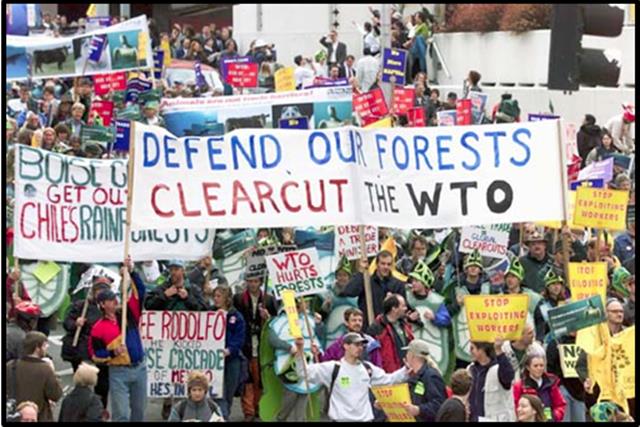
Interest Groups Protesting
the Policies of the WTO, 1999
Legal Action
Interest groups first try to enact change by working
through the legislative and executive branches of government. When this proves ineffective, they turn to litigation or lawsuits within the
judicial branch. Class action suits are filed by one person on behalf of everyone
who would benefit from the court’s decision.
Environmental, civil rights and consumer organizations often use this
tactic. One of the most famous examples
is Brown v Board of Education. This class action suit was initiated by the
NAACP and ended school segregation. Interest
groups frequently make their views known to the judicial branch by preparing amicus curiae (a Latin phrase meaning “a
friend of the court”) briefs for the court.
These documents explain why a group is working for or against a
particular ruling.
 Go to Questions 8 through 15.
Go to Questions 8 through 15.
Propaganda and the Art of Persuasion
The effectiveness of an interest group depends on
the ability to convince others that its recommendations offer the best
alternative. This results in the
application of propaganda. The word has developed a negative connotation
because it often refers to information that is misleading or false. In reality, propaganda is any type of
persuasive communication that is used to sway opinions, actions or
emotions. It includes everything from
factual evidence to blatant lies. Not
only interest groups but political parties, candidates for office and
advertisers incorporate some degree of propaganda to generate support. Learning to recognize common propaganda
techniques is part of being an informed citizen. A number of these can be found in the
following diagram.
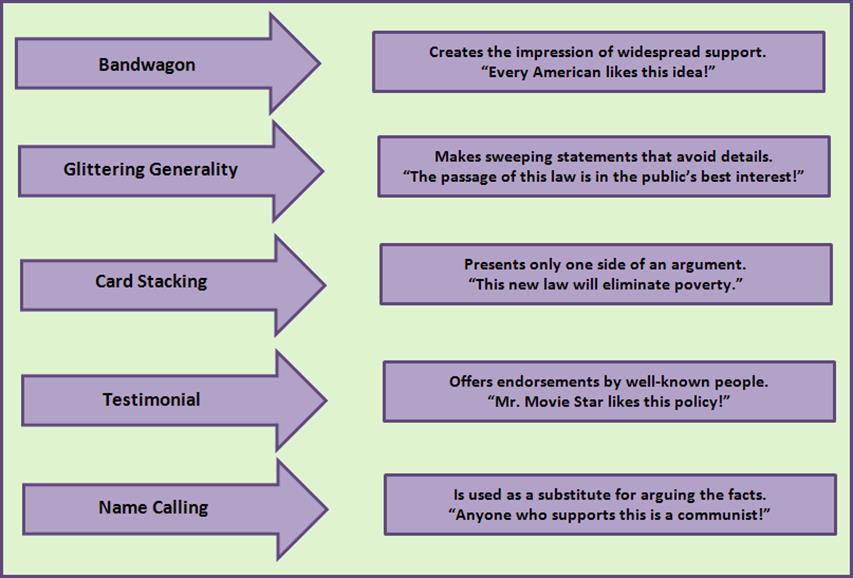
Political Action Committees (PACs)
Most tactics used by interest groups to emphasize
their causes require large amounts of funding.
Historically, federal law did not permit corporations or labor unions to
contribute to political parties and candidates.
This began to change in 1944.
That year, the Congress of Industrial Organizations (CIO), a labor
union, wanted to support the re-election of Franklin Roosevelt. They got around the law by encouraging their
members to donate voluntarily to Roosevelt’s campaign. This created the first political action
committee. These committees, commonly
referred to as PACs, are dedicated to raising and spending money. The funds, which they collect from
corporations, unions and interest groups, are used to influence public policy
by electing or defeating political candidates.
With changes in federal election laws, the number of PACs has continued
to increase. In 1974, about 600 PACs throughout
the United States spent $12,500,000 attempting to elect certain candidates to
Congress. In 2012, over 4000 PACs spent
nearly $568,000,000 on state and national elections.
 Go to Questions 16 and 17.
Go to Questions 16 and 17.
The Pros and Cons of Special Interest
Groups
Interest groups have certainly become a powerful
force in American politics, but whether they affect the system in a positive or
negative way is the subject of a heated debate.
Small interest groups are sometimes criticized because they influence
public policy by generating large amounts of publicity. This exaggerates the significance of causes
which, in reality, are of little national importance. Critics point out that the financial
resources of some groups create an unfair advantage. A well-funded organization, with relatively
low number of members, can have greater impact on government decisions than a
group with more members but fewer resources.
The leadership of interest groups has also become a source of
controversy. In some cases, small,
active committees do not consult the membership as a whole when planning the
agenda for the group. There is also a
fear that interest groups put too much pressure on elected officials. Instead of moving government forward, this
may result in a lack of action and weaker policies. Although it is rare, interest groups have
been known to resort to violence, bribery, hacking and other unethical
activities to accomplish their goals.
All of these factors have led some Americans to conclude that interest
groups distort the issues, make government less productive and engage in
illegal practices.
However, some Americans see interest groups as a
positive force. Like political parties,
they enable people to accomplish collectively what they cannot do
individually. Interest groups provide
the means to share resources, to develop strategies and to form new ideas into
workable plans. They also acquire and
organize valuable information on a wide variety of topics. Although their material may only present one
side of an issue, every branch of government relies on their expertise. These organizations also give citizens a
reason to stay informed and to become active in politics. At the very least, they provide a basis for
discussion and interaction. Competition
among opposing interest groups is also beneficial. This presents a few groups from exerting too
much influence over the decision-making process and has a stabilizing effect on
American politics. The example below
represents the view of two groups that are opposite sides concerning gun
control.
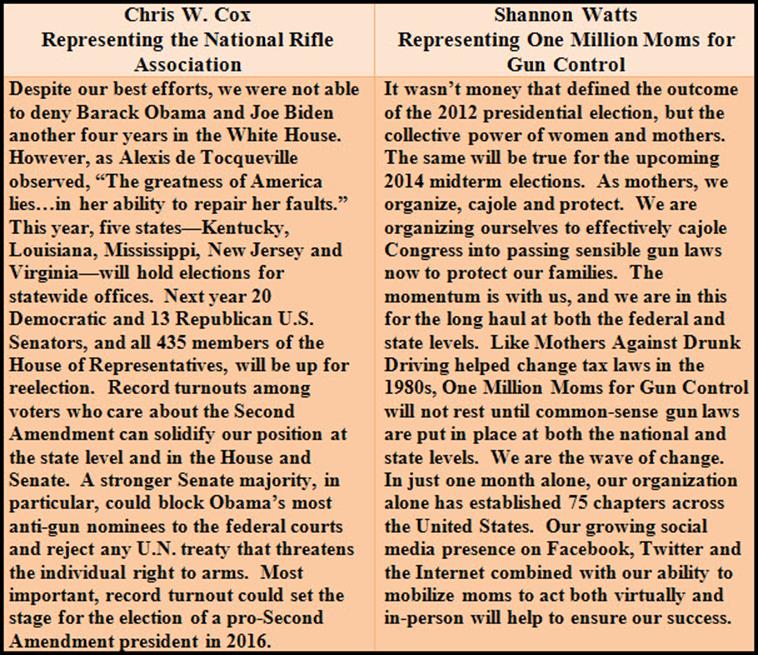
 Go to Questions 18 through 20.
Go to Questions 18 through 20.
What’s Next?
Interest groups encourage government to address a
wide array of issues and to take action.
Meeting these demands involves the government’s authority to tax and to
spend public funds. In the next unit,
you will consider how this money is collected and allocated. Before moving on to the next unit, review
Unit 13 and complete questions 21 through 28.
 Go to Questions 21 through 28.
Go to Questions 21 through 28.

Below are additional educational resources and activities for this unit.